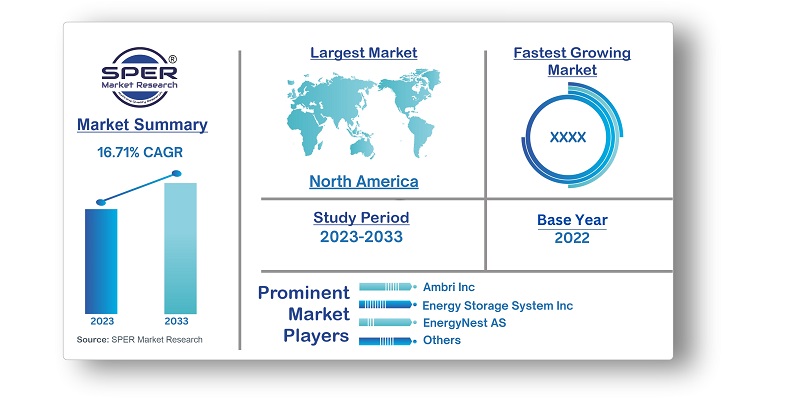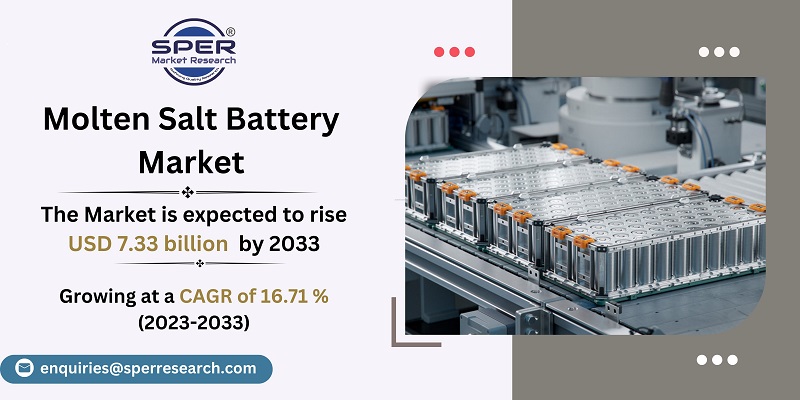
Molten Salt Battery Market Growth, Size, Trends, Demand, Revenue, Share and Future Outlook
Molten Salt Battery Market Size- By Application, By Type- Regional Outlook, Competitive Strategies and Segment Forecast to 2033
| Published: Jan-2024 | Report ID: POAE2406 | Pages: 1 - 227 | Formats*: |
| Category : Power & Energy | |||
- June 2019; NGK Insulators, Ltd. and BASF New Business GmbH signed a sales cooperation agreement to sell NGK's sodium sulphur batteries through its international networks.
- May 2019; the Noor III CSP tower in Morocco is producing outputs that are higher than expected. Using molten salt storage technology, the plant is one of the biggest operational CSP power plants in the world.


| Report Metric | Details |
| Market size available for years | 2019-2033 |
| Base year considered | 2022 |
| Forecast period | 2023-2033 |
| Segments covered | By Application, By Type |
| Regions covered | North America, Asia-Pacific, Latin America, Middle East & Africa and Europe |
| Companies Covered | Ambri Inc., Energy Storage System Inc., EnergyNest AS, Enevate Corporation, Enphase Energy, Inc., FZSoNick, Halotechnics, Inc., NGK Insulators, Ltd., SolarReserve, LLC, Sumitomo Electric Industries, Ltd. and others. |
- Renewable Energy Developers
- Electric Vehicle Manufacturers
- Energy Storage Companies
- Utility Providers
- Investors and Venture Capital Firms
| By Application: |
|
| By Type: |
|
| By Region: |
|
- Global Molten Salt Battery Market Size (FY’2023-FY’2033)
- Overview of Global Molten Salt Battery Market
- Segmentation of Global Molten Salt Battery Market By Application (Concentrated Solar Power, Electric Vehicles, Grid Storage)
- Segmentation of Global Molten Salt Battery Market By Type (Lithium-based, Potassium-based, Sodium-based)
- Statistical Snap of Global Molten Salt Battery Market
- Expansion Analysis of Global Molten Salt Battery Market
- Problems and Obstacles in Global Molten Salt Battery Market
- Competitive Landscape in the Global Molten Salt Battery Market
- Impact of COVID-19 and Demonetization on Global Molten Salt Battery Market
- Details on Current Investment in Global Molten Salt Battery Market
- Competitive Analysis of Global Molten Salt Battery Market
- Prominent Players in the Global Molten Salt Battery Market
- SWOT Analysis of Global Molten Salt Battery Market
- Global Molten Salt Battery Market Future Outlook and Projections (FY’2023-FY’2033)
- Recommendations from Analyst
1.1. Scope of the report1.2. Market segment analysis
2.1. Research data source2.1.1. Secondary Data2.1.2. Primary Data2.1.3. SPER’s internal database2.1.4. Premium insight from KOL’s2.2. Market size estimation2.2.1. Top-down and Bottom-up approach2.3. Data triangulation
4.1. Driver, Restraint, Opportunity and Challenges analysis4.1.1. Drivers4.1.2. Restraints4.1.3. Opportunities4.1.4. Challenges4.2. COVID-19 Impacts of the Global Molten Salt Battery Market
5.1. SWOT Analysis5.1.1. Strengths5.1.2. Weaknesses5.1.3. Opportunities5.1.4. Threats5.2. PESTEL Analysis5.2.1. Political Landscape5.2.2. Economic Landscape5.2.3. Social Landscape5.2.4. Technological Landscape5.2.5. Environmental Landscape5.2.6. Legal Landscape5.3. PORTER’s Five Forces5.3.1. Bargaining power of suppliers5.3.2. Bargaining power of buyers5.3.3. Threat of Substitute5.3.4. Threat of new entrant5.3.5. Competitive rivalry5.4. Heat Map Analysis
6.1. Global Molten Salt Battery Market Manufacturing Base Distribution, Sales Area, Product Type6.2. Mergers & Acquisitions, Partnerships, Product Launch, and Collaboration in Global Molten Salt Battery Market
7.1. Global Molten Salt Battery Market Value Share and Forecast, By Application, 2023-20337.2. Concentrated Solar Power7.3. Electric Vehicles7.4. Grid Storage
8.1. Global Molten Salt Battery Market Value Share and Forecast, By Type, 2023-20338.2. Lithium-based8.3. Potassium-based8.4. Sodium-based
9.1. Global Molten Salt Battery Market Size and Market Share
10.1. Global Molten Salt Battery Market Size and Market Share By Application (2019-2026)10.2. Global Molten Salt Battery Market Size and Market Share By Application (2027-2033)
11.1. Global Molten Salt Battery Market Size and Market Share By Type (2019-2026)11.2. Global Molten Salt Battery Market Size and Market Share By Type (2027-2033)
12.1. Global Molten Salt Battery Market Size and Market Share By Region (2019-2026)12.2. Global Molten Salt Battery Market Size and Market Share By Region (2027-2033)12.3. Asia-Pacific12.3.1. Australia12.3.2. China12.3.3. India12.3.4. Japan12.3.5. South Korea12.3.6. Rest of Asia-Pacific12.4. Europe12.4.1. France12.4.2. Germany12.4.3. Italy12.4.4. Spain12.4.5. United Kingdom12.4.6. Rest of Europe12.5. Middle East and Africa12.5.1. Kingdom of Saudi Arabia12.5.2. United Arab Emirates12.5.3. Rest of Middle East & Africa12.6. North America12.6.1. Canada12.6.2. Mexico12.6.3. United States12.7. Latin America12.7.1. Argentina12.7.2. Brazil12.7.3. Rest of Latin America
13.1. Ambri Inc.13.1.1. Company details13.1.2. Financial outlook13.1.3. Product summary13.1.4. Recent developments13.2. Energy Storage System Inc.13.2.1. Company details13.2.2. Financial outlook13.2.3. Product summary13.2.4. Recent developments13.3. EnergyNest AS13.3.1. Company details13.3.2. Financial outlook13.3.3. Product summary13.3.4. Recent developments13.4. Enevate Corporation13.4.1. Company details13.4.2. Financial outlook13.4.3. Product summary13.4.4. Recent developments13.5. Enphase Energy, Inc.13.5.1. Company details13.5.2. Financial outlook13.5.3. Product summary13.5.4. Recent developments13.6. FZSoNick13.6.1. Company details13.6.2. Financial outlook13.6.3. Product summary13.6.4. Recent developments13.7. Halotechnics, Inc.13.7.1. Company details13.7.2. Financial outlook13.7.3. Product summary13.7.4. Recent developments13.8. NGK Insulators, Ltd.13.8.1. Company details13.8.2. Financial outlook13.8.3. Product summary13.8.4. Recent developments13.9. SolarReserve, LLC13.9.1. Company details13.9.2. Financial outlook13.9.3. Product summary13.9.4. Recent developments13.10. Sumitomo Electric Industries, Ltd.13.10.1. Company details13.10.2. Financial outlook13.10.3. Product summary13.10.4. Recent developments13.11. Others
SPER Market Research’s methodology uses great emphasis on primary research to ensure that the market intelligence insights are up to date, reliable and accurate. Primary interviews are done with players involved in each phase of a supply chain to analyze the market forecasting. The secondary research method is used to help you fully understand how the future markets and the spending patterns look likes.
The report is based on in-depth qualitative and quantitative analysis of the Product Market. The quantitative analysis involves the application of various projection and sampling techniques. The qualitative analysis involves primary interviews, surveys, and vendor briefings. The data gathered as a result of these processes are validated through experts opinion. Our research methodology entails an ideal mixture of primary and secondary initiatives.



Frequently Asked Questions About This Report
PLACE AN ORDER
Year End Discount
Sample Report
Pre-Purchase Inquiry
NEED CUSTOMIZATION?
Request CustomizationCALL OR EMAIL US
100% Secure Payment






Related Reports
Our Global Clients
Our data-driven insights have influenced the strategy of 200+ reputed companies across the globe.






















